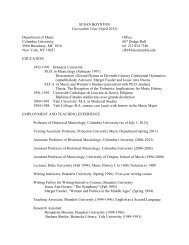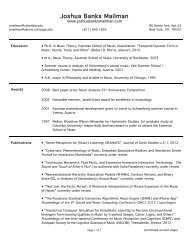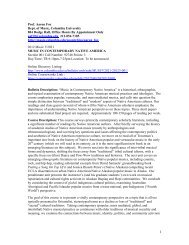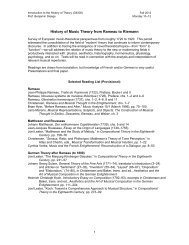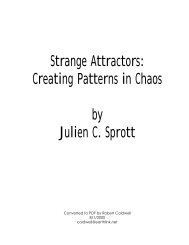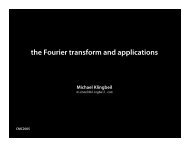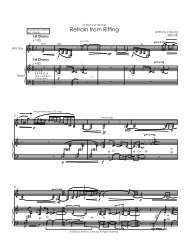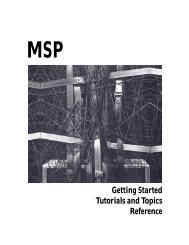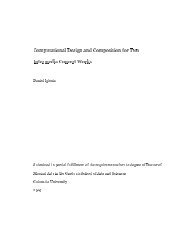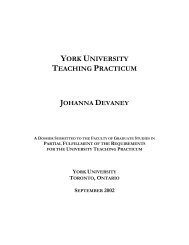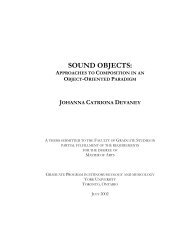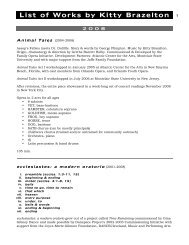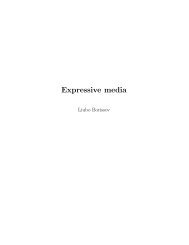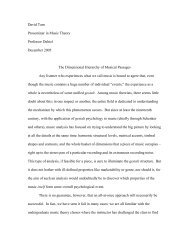The JPMorganChase Kids Digital Movement and Sound - Columbia ...
The JPMorganChase Kids Digital Movement and Sound - Columbia ...
The JPMorganChase Kids Digital Movement and Sound - Columbia ...
Create successful ePaper yourself
Turn your PDF publications into a flip-book with our unique Google optimized e-Paper software.
PROGRAM NOTES<br />
PART I: <strong>The</strong> <strong>Digital</strong> <strong>Sound</strong> project<br />
For the sound project of the <strong>JPMorganChase</strong> <strong>Kids</strong> <strong>Digital</strong> <strong>Movement</strong> <strong>and</strong> <strong>Sound</strong> Project,<br />
children use digital technologies to record <strong>and</strong> study the sounds of their environment <strong>and</strong> their<br />
own voices. <strong>The</strong>y use the knowledge gained from this study to synthesise their own digital<br />
compositions. <strong>The</strong> children employ user-friendly tools geared to their developmental levels,<br />
but in a highly sophisticated context - a distributed or ubiquitous computing environment in<br />
which machine intelligence is not restricted to a fixed CPU <strong>and</strong> monitor, but is instead<br />
deployed in mobile formations throughout the learning environment. A large part of the<br />
control of the digital synthesis is achieved through external controllers that offer children a<br />
direct physical relationship to the elements of sound. <strong>The</strong> children work in teams <strong>and</strong> create<br />
the compositions collectively. <strong>The</strong> script (form) of the resulting compositions evolves from<br />
the soundscapes that the children experience <strong>and</strong> analyse. <strong>The</strong> children are encouraged to<br />
listen to the interaction of the sound elements of each soundscape <strong>and</strong> to incorporate this<br />
interactivity in their group compositions. In such an environment, children see that<br />
organisation can arise as a consequence of emergent structure (the unanticipated interaction of<br />
numerous interdependent elements) rather than from top-down design. Our ultimate goal is to<br />
enhance the sonic experience <strong>and</strong> connect it as directly as possible to sonic creation without<br />
the interference or mediation of external artificial processes.<br />
Tonight you will hear works in progress form the first four initiatives of this sound project:<br />
In A Walk Through Harlem <strong>The</strong> performers tell the story of a February walk through Harlem,<br />
where they recorded the sounds of the neighborhood <strong>and</strong> of various things they found. Using<br />
several unique digital instruments, they mix <strong>and</strong> modify these sounds <strong>and</strong> the sounds of their<br />
own voices, telling a sonic story. Images of their walk accompany them, in an unusual<br />
computerized slide-show that responds to their performance.<br />
<strong>Kids</strong> in (<strong>Sound</strong>)Space is a live, collaborative, interactive composition. Environmental sounds<br />
that were recorded by the group (supermarket noises, buses, the subway) are loaded into a<br />
computer. <strong>The</strong>se sounds are represented by objects that float around on the computer screen.<br />
<strong>The</strong> performers can control the motion of the sound objects via sensors they wear on their<br />
bodies. As the objects move around on the screen their qualities change: volume, spatial<br />
location, pitch, tempo <strong>and</strong> a number of other parameters can be altered for each sound. When<br />
a number of sounds are loaded at the same time, a sound environment, or space, is formed. In<br />
performance, a new piece is created every time as the performers work with the sounds in the<br />
sound space to create environments <strong>and</strong> moods that change over time.<br />
During the workshops for the creation of Wind Symphony children using filtered noise attempt<br />
at first to re-create natural noised-based sound environments: the sound of the waves, the<br />
sound of the wind, the noise of traffic, the noise of crowds, blowing wind in tubes, noise<br />
based speech syllables, noise based animal sounds. Children experiment extensively with<br />
frequency content, frequency contour <strong>and</strong> amplitude envelopes, <strong>and</strong> their<br />
interaction/integration. Through their experimentation with the creation of natural noisedbased<br />
environments, of which they have strong implicit knowledge, children familiarise<br />
themselves with digital synthesis techniques. <strong>The</strong>y are then able to use these techniques to



